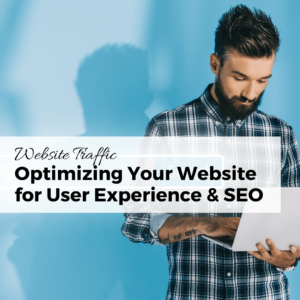- +1 512-591-8295
- [email protected]
- Mon - Fri: 9:00 - 16:00

In the digital age, your website is often the first point of contact between your business and potential customers. It’s your digital storefront, your online business card, and your 24/7 salesperson. But is your website truly optimized for both user experience and SEO? If not, you could be missing out on valuable opportunities to attract, engage, and convert visitors into customers.
Here are five essential steps to optimize your website for both user experience and SEO. These steps are designed to help entrepreneurs like you, who are focused on growth and understand the importance of getting things right from the beginning.
Before you can optimize your website for your audience, you need to understand who your audience is and what they’re looking for. This involves creating detailed buyer personas and conducting keyword research to understand the terms your audience uses when searching for your products or services.
Once you understand your audience, you can tailor your website’s content to their needs and preferences. This means using the language they use, addressing their pain points, and offering solutions to their problems.
Your website’s content should provide value to your audience. This means offering informative, engaging, and relevant content that answers their questions and helps them solve their problems while establishing your own authority.
Consistency is key when it comes to content creation. This means regularly updating your website with new content and ensuring that all content is consistent in tone and style. This helps both your audience and search engines.
Site speed is a critical factor in both user experience and SEO. A slow-loading website can frustrate users and lead to high bounce rates, which can negatively impact your SEO rankings. Although keep in mind, if your audience really wants to access your content, they will wait, but it’s always better if they don’t have to.
With more and more people accessing the internet via mobile devices, it’s crucial that your website is mobile-friendly. This means ensuring that your website is responsive and that it looks and functions well on all devices. This could be things like making sure that clickable elements have enough space to click with a finger and not accidentally click the wrong link.
Keywords are the terms that people use to search for your products or services. By incorporating these keywords into your website’s content, you can improve your visibility on search engine results pages (SERPs).
Meta tags are snippets of text that describe a page’s content. They don’t appear on the page itself, but in the page’s code. Well-crafted meta tags can help search engines understand your content and improve your visibility on SERPs. While Google doesn’t need them so much any more, some of the less-used platforms still do, so making sure they clearly convey the contents of the page can still be beneficial.
To understand whether your optimization efforts are working, you need to track your website’s performance. This involves using tools like Google Analytics to monitor your traffic, bounce rate, and conversion rate.
Based on your analysis, you may need to make adjustments to your website. This could involve tweaking your content, improving your site speed, or refining your SEO strategy.
By following these five steps, you can optimize your website for both user experience and SEO, helping you attract more visitors, engage them effectively, and ultimately convert them into customers. Remember, your website is a crucial tool in your marketing arsenal – make sure it’s working hard for you.
Remember, at Vicky Wu Marketing Agency, we understand the importance of getting branding and voice right quickly to hone marketing efforts. We offer knowledge to entrepreneurs at a rate accessible to entrepreneur budgets. Many clients have said they didn’t even know what was possible until they started working with us.
Your website is a crucial tool in your marketing arsenal – make sure it’s working hard for you. If you need help optimizing your website for user experience and SEO, don’t hesitate to reach out to us. We’re here to help you succeed.
Curious how you can increase your website traffic?
Get solid marketing strategies, designed for entrepreneurs on the track to 7-figures and beyond, right in your inbox.

This website uses cookies to ensure you get the best experience on our website. By continuing to use the website, you agree to our use of cookies. We do not share or sell your information. More info
